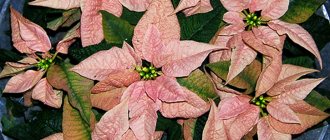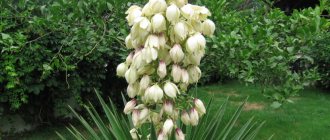With the onset of autumn, most garden plants fade, but if chrysanthemums are planted in a flowerbed, then with their fresh buds and variety of colors they will be able to delight you almost until the first snow. Chrysanthemum Bacardi is one of the varieties of this plant, bred relatively recently (in 2004), and it is this new product that will be discussed in this article.
Chrysanthemum Bacardi is a tall type of chrysanthemum and grows as a bush. Due to the strong and elastic stem, which retains this property even after pruning, as well as the ability to withstand transportation well, this plant is often grown for cutting. Compositions with Bacardi chrysanthemum are distinguished by their high durability and the ability, with good care, to remain fresh for a long time, as when they were purchased. The above properties allow this plant to be used in bouquets both alone and in compositions with other flowers. It is worth noting that the structure of the Bacardi chrysanthemum inflorescences, if necessary, makes it possible to apply glitter to them and paint them with special paints in different colors.
When flowering, the Bacardi chrysanthemum produces small, chamomile-shaped flowers with a yellow or green core. The colors of the flowers are varied and range from white, yellow (sunny), cream, red (Bordeaux) to pink and pearl.
It is worth noting that the Bacardi chrysanthemum belongs to a conventional group of Korean chrysanthemums, i.e., cold-resistant plants that are very popular in cold regions, where they successfully winter in open ground. A distinctive feature of this variety of chrysanthemums can be considered its presentation - it took place in the summer of 2004 at a concert of the Dutch singer Marco Borsato, where he personally presented the Bacardi chrysanthemum to the public.
Growing chrysanthemums in the garden does not require much effort, so they are quite common among gardeners. In addition, a beautiful bouquet can be grown at home in a flowerpot, for this you just need to provide the plant with certain conditions.
Chamomile bush chrysanthemum “Bacardi”: description of the variety
Bouquet of multi-colored Bacardi chrysanthemums
Tall bush single-flowered daisy-shaped Bacardi chrysanthemums belong to the early varieties. They begin to bloom in July and continue to bloom until the end of September. When grown in open ground, they can reach a height of one and a half meters. Therefore, when growing in flower beds and garden beds, they sometimes have to be tied up. Fortunately, they are elastic and durable, so they do not break.
Chrysanthemum Bacardi has a strong green stem, which allows it to be used in a variety of flower arrangements. After cutting, it retains its freshness and durability for a long time (up to three weeks).
The leaves of the Bacardi chrysanthemum variety are carved, divided into several parts. Their color is dark green, rich. The main advantage of the plant is its delicate inflorescences: round, durable, velvety petals tightly surround an open green core. The flowers are simple, non-double. The size of the flowers reaches 7.5 cm in diameter and depends on the characteristics of plant care. If the number of buds on one flower is controlled, excess buds are removed, and the inflorescences are large. If this is not done, up to 7 flowers of smaller diameter appear on each branch. The core size is about 1.5 cm. The petals are durable. The color of the petals may vary. The incredibly decorative appearance and rich palette allows Bacardi to bear the proud title of “Queen of Bouquets”.
Variety varieties:
- Bacardi White Chrysanthemum. The boiling white color of the inflorescences, shown in the photo above, makes it very similar to chamomile and popular in wedding bouquets. The difference between the Bacardi white bush chrysanthemum is in the color of the flower core. If chamomile is yellow, then Bacardi White is green. In addition, chrysanthemum petals are larger and rounder.
Chrysanthemum "Bacardi White" - Chrysanthemum Bacardi Sani Chrysanthemum stands out with its bright yellow color and is perhaps one of the most cheerful and sunny in the group. Even single-color bouquets of yellow Bacardi spray chrysanthemums look incredibly attractive. Chrysanthemum "Bacardi Sunny"
- Bacardi Cream (Chrysanthemum Bacardi Cream) is characterized by inflorescences with delicate cream petals. In combination with the green core and dark green leaves, they look very unusual. In compositions they are combined with other colors in pastel shades or contrasting combinations with yellow, blue, burgundy, and red shades are created.
Chrysanthemum "Bacardi Cream" - Bacardi Bordo Chrysanthemum. Bright flowers in rich red and burgundy shades, against which the unusual yellow-green cores are especially noticeable. In bouquets they create an incredibly beautiful effect with white flowers. Chrysanthemum "Bacardi Bordeaux"
- Spray chrysanthemum Bacardi pink (Bacardi Pearl Chrysanthemum). The petals are soft pink with a pearlescent tint. When composing bouquets that include the Bacardi Pearl chrysanthemum, florists often decorate the inflorescences with sparkles and rhinestones, which makes them even more attractive. Chrysanthemum "Bacardi Pearl"
These unusual flowers can also be given a new color using special dyes added to the soil when growing the white variety. In this way, you can get, without exaggeration, any shade: bacardi chrysanthemum lilac, blue, blue, salmon, rainbow - each flower is unique and can become the main decoration of the bouquet.
10 reasons why a pear tree does not bloom or bear fruit if it is already 5 years old and what to do
general characteristics
Chrysanthemum variety Bacardi is a tall bush plant; its stems grow up to 1.2–1.5 m, but they do not break due to their strength and flexibility. But they are tied up so that the plant does not lose its presentation (the leaves and flowers do not get dirty with soil, the stem remains straight). Graceful carved leaves, divided into several parts, are painted in a rich dark green color; they perfectly set off the not too large flowers of white, pink, cream, dark burgundy or bright yellow.
A simple non-double flower has the shape of a daisy - the middle with a diameter of up to 1.5 cm is surrounded by petals, so that a fully bloomed flower most often has a diameter of 6.5 cm. The middle is green or yellowish-green, the petals are quite durable, florists sometimes paint them in other unexpected colors , they even put glitter on it. Cut flowers decorate the interior for several weeks. The bush can be grown in a flowerbed or at home in a pot; caring for it is traditional. Chrysanthemums love nutritious, water- and breathable soil, neutral or sour, a lot of sun, and average air temperature.
In the garden, they are planted on an open lawn slightly at an elevation, at least not in a hollow or lowland, to avoid possible stagnation of moisture. If the soil is heavy, it is worth digging a larger hole, laying out a drainage layer, and already prepared (corrected) soil on top of it. In spring, the bushes must be pruned so that they grow lush and form many shoots. In summer and autumn, sanitary pruning is done, and with the beginning of the formation of buds, their number is normalized, pinching off the excess ones.
It is necessary to moisten moderately, without allowing the soil to dry out completely; in the spring you can add nitrogen or, better yet, complex mineral fertilizers, and in the summer you no longer need to give nitrogen, only potassium. At the end of summer, you can feed the bushes with a potassium-phosphorus mixture to improve flowering and help them endure winter more easily. If the winter is expected to be harsh, then you can build a frame of wire or wooden slats over the plant, and lay insulating material (non-woven fabric or something similar) on it.
At home, you need to plant the chrysanthemum in a large pot and replant it annually. The most comfortable temperature for Bacardi is +17 °C. Heat will slow down flowering, may cause yellowing of leaves, slow growth
Chrysanthemums respond well to fertilizing with infusion of bird droppings, but it must be diluted very strongly (20:1), watered carefully on damp soil
How to plant Bacardi chrysanthemum in the garden
Chrysanthemum Bacardi is as unpretentious as any other. The agricultural technology for growing this flower does not differ from the rules for caring for representatives of the Astrov family.
Selecting a location
The planting site should be located on a hill so that moisture does not stagnate at the roots. Preferably a lighted place without drafts, then the flower will be comfortable there.
How to prepare the soil
The flower requires loose, nutritious soil that easily allows air and moisture to pass through. The soil can be improved by digging with a little organic fertilizer. For greater ease, you can add sand or sawdust.
Features of planting chrysanthemums before winter
When planting a plant in August-September, the bush will have time to adapt before the onset of cold weather. A rooted plant will overwinter without any problems.
Later planting, occurring in October-November, is not advisable. It is better to leave the bush for the winter in a dry cellar.
Features of wintering
Planting chrysanthemums in the garden and caring for them forces you to annually prepare the plants for wintering. This is necessary in order to preserve the varieties you like.
If the plant is grown in regions with mild and warm winters, where there are no frosts below -7 degrees, then the bushes are covered with spruce branches or covering material for the winter. The plants are first trimmed, leaving no more than ten centimeters of the above-ground part.
In regions with harsher winters, chrysanthemums must be dug up, planted in pots and stored in a cool room until the next season. With the arrival of spring, they are transferred to the site, having previously prepared the flowerbed: they apply fertilizers, renew the soil, and prepare planting holes with drainage laid at the bottom.
Chrysanthemum Bacardi - what kind of flower is it, varieties
The variety was bred in 2004 in the Netherlands. After cutting, Bacardi does not wither for a long time, so the variety is often used for bouquets.
Chrysanthemum Bacardi looks very beautiful in group plantings with other flower crops.
Bacardi Cream (Chrysanthemum Bacardi Cream)
The petals of the blossoming inflorescences are of a soft cream color. The core is green.
Bacardi Sani Chrysanthemum
Chrysanthemum variety Sunny is characterized by rich yellow flowers.
Bacardi can be any color
Bacardi White Chrysanthemum
The petals of the inflorescences are milky-white, the core is yellow-green.
Bacardi Bordo Chrysanthemum
Like the Bacardi white bush chrysanthemum, this variety is distinguished by the green-yellow core of the inflorescences. The petals of the inflorescences are a rich burgundy shade.
Chrysanthemum Bacardi Bordeaux
Bush Bacardi pink (Bacardi Pearl Chrysanthemum)
Blooming inflorescences are soft pink with a lavender tint.
Features of plant flowering
Chrysanthemums usually bloom towards the end of summer or early autumn. This applies to both flowers grown in the garden and indoor specimens.
- Period of activity and rest
The onset of flowering largely depends on temperature. The optimal heat level for bud formation is considered to be within 15-18 °C.
Chrysanthemums that are grown indoors need to rest by pruning them after flowering and putting them in a room with a temperature of 2-3 °C.
- Types and shape of flowers
The daisy-shaped flowers come in shades of pink, cream, yellow, burgundy and red.
This is interesting! White bush chrysanthemum Bacardi is the most memorable variety of this variety. Flowers that are most similar to chamomile invariably arouse people's interest.
- Care after flowering
As flowers fade, faded buds should be removed from the bush. This will extend the flowering period, and the plant itself will not lose its decorative qualities and will look neat.
Chrysanthemum Bacardi
This variety was bred relatively recently, in 2004. The flower was presented to the public at a concert of the Dutch singer Marco Borsato. This chrysanthemum does not lose its quality when cut, can easily be transported, and is very stable in bouquets.
Bacardi is one of the most favorite flowers in bouquets
Bacardi belongs to the Astrov family. According to the description, the plant is a bush chrysanthemum. Its tall bushes can grow up to 1.5 meters in height. The stem is straight and strong, covered with rather large carved leaves, similar to oak leaves.
The flowers, 6.5 cm in diameter, resemble a real daisy with a convex yellowish-green center. Petals can have different colors.
Proper care
With good care, chrysanthemum will delight you with long and abundant flowering.
The plant needs plenty of watering because its roots are located near the surface of the soil.
With insufficient moisture, the flower stems become woody, and the inflorescences become loose and few in number.
It is better to take settled or rain water for irrigation; it is recommended to add two drops of ammonia to it. You need to water the bush at the root; after moistening, the soil around the flower should be loosened well, but this must be done carefully so as not to damage the root system. You can also mulch the bushes; this procedure helps conserve moisture.
Chrysanthemums need systematic feeding. At the beginning of the growing season, it is worth using fertilizers containing nitrogen; they help the plant quickly grow green mass. Before budding begins, you need to add potassium and phosphorus fertilizers, which will activate lush flowering.
It is recommended to apply liquid fertilizers, pouring them under the roots of the plant; it is appropriate to do this two days after watering or rain. The first time the chrysanthemum is fertilized 2 weeks after planting, for this, 20 g of ammonium nitrate and azophosphate are diluted in 10 liters of water and the plant is watered.
The formation of a bush is necessary for a beautiful and well-groomed appearance of the plant; this is done with the help of pinching, which is done in the summer. Using this procedure, the tops of the shoots are pinched until the buds appear. Thus, the bush forms a lush crown, sometimes up to 40 flowers are formed on it. This operation promotes long and abundant flowering.
It is also worth removing the stepsons growing from the axils of the leaves, and in the summer removing the shoots and buds that form on the sides.
Preparing for wintering will help the plant survive winter normally in open soil. To increase the immunity of the bush and make it more resistant to cold, it is worth feeding the chrysanthemum with phosphorus-potassium fertilizers. The flower is resistant to autumn frosts, but with the onset of frost it must be cut at a height of 10 cm from the soil and covered with dry leaves.
Bacardi chrysanthemum
The Bacardi variety was developed relatively recently - in 2004. It was then that the Dutch singer Marco Borsato presented the new product to the public at his concert. The flower quickly gained immense popularity due to its “commercial” qualities. Like all chrysanthemums, Bacardi does not wither for a very long time after cutting. The stem has good strength and elasticity, so the bouquet does not suffer during transportation.
Although the genus of chrysanthemums (Chrysánthemum - translated from Latin as “golden-colored”) is known for the fact that the flowers always have a yellow tint, the modern variety of varieties covers almost the entire spectrum of colors.
Chrysanthemum
With its shape, the flower most closely resembles the well-known garden daisy. The diameter of the corolla is 6.5 cm, and the core is much smaller - only 1.5 cm in diameter. The benefit of the plant lies not only in its exceptional attractiveness and pleasant aroma, although, of course, decorative varieties are grown precisely for the beauty of the flowers. In Japan, wine is made from the ground part and is also used in cooking. Extracts from the petals have found application in cosmetology.
Varieties of bush chrysanthemums and their photos
Among the popular varieties of spray chrysanthemum are the following: Lollipop pink, Grand Pink, Amira, Anastacia white, Artist pink, Artist yellow, Bacardi, Baltika, Bizritz, Dance, Feeling green, Green lizard, Mona Liza, Joy, Saba.
On this page you can read descriptions of varieties of bush chrysanthemums and see their photos:
Chrysanthemum "Bacardi" has a variety of flower colors: from snow-white to pink, and can even have a yellow tint.
The stem of the flower is quite strong and does not break when pruned. This is important when composing various flower arrangements.
The flower itself has a diameter of 65 millimeters, and its middle is 15 millimeters.
This chrysanthemum was first presented in June 2004 at a concert of singer Marco Borsato. The singer himself showed the public this variety of bush chrysanthemum.
Below is a photo of a bush chrysanthemum, which illustrates the richness of colors:
Chrysanthemum "Reagan" has a yellow-green core and a halo of silky elongated leaves. The flower itself is red. This gives the flower a special attractiveness.
The color develops within 25-30 days. Its flowers are medium in size.
The stem grows to 75-80 centimeters in length.
The plant is named after American President Ronald Reagan.
Spray chrysanthemum “Cream Joy” is a cream-colored spray chrysanthemum with a green core.
A unique feature of this flower is the peculiar color of its flowers - in the central part they are green, and a little closer to the edges of the petals the color becomes lighter, moving from bright green to light green, and then to yellow or cream.
The flower bud has a round shape.
The leaves are a juicy dark green hue.
The 'Green Lizard' spray chrysanthemum has bright green petals and daisy-shaped flowers. A distinctive feature of the plant is that it has a high degree of persistence and remains fresh for a long time.
Bush chrysanthemum "Saba" is a variety that has dense foliage with deep longitudinal grooves.
A very large number of large-sized flowers bloom on each branch of the plant. Their shape is associated with a basket, which has a bright yellow color and a bright green core.
On the edges of the yellow-hued basket you can see long and thin, pointed petals of a snow-white flower.
The outer petals of the inflorescence are curled and seem to be moving, as if the wind is blowing on them.
The diameter of the flower is up to 5 centimeters.
The bush reaches a height of 60-70 centimeters.
Planting and growing
Chrysanthemum "Bacardi", like other varieties of this plant, is grown quite simply. In order for a flower to please you with abundant blooms and a beautiful appearance, you just need to follow a number of simple rules.
First you need to choose a good place to plant the plant. Chrysanthemum does not like extreme heat and too cold temperatures, so the planting site should be slightly shaded so that the bright rays of the sun are dissipated.
In addition, it is very important not to plant Chrysanthemum in lowlands, since this flower has a negative attitude towards stagnant water. It is best to choose higher places so that groundwater cannot reach the plant.
The soil for Chrysanthemums must be porous in order to allow air and moisture to pass through well. If the soil on your site is too heavy, be sure to add a drainage layer to the bottom of the hole.
Another important condition that must be taken into account when planting Chrysanthemums is the distance between the bushes. It must be at least 25 centimeters for the flowers to grow beautiful and large.
Immediately after planting, the Chrysanthemum bush should be sprayed with water and covered. The plant will delight you with its first flowering about a year after planting.
Landing rules
Bacardi seedlings and bushes are planted in open ground in the spring, after it has warmed up to + 12-14 °C to a depth of 20 cm. The exact timing of the event cannot be given. They vary in different regions. So, in the south, planting is carried out after spring frosts, in early April. In the Urals and Siberia, seedlings are planted in early May.
Important! In order for the seedlings to take root better, they are planted on a cloudy day when the bright sun does not shine.
For planting, choose a place on a hill. This is necessary to ensure that there is no stagnation of liquid and the root system does not rot. It is important that the site is protected from strong winds and illuminated by the sun for at least 6 hours a day. The soil should be loose and fertile. If it is dense and depleted, rotted manure is added to it. However, it is important not to overuse it, otherwise Bacardi will form an overly lush green mass and flowering will be poor. For planting, choose strong seedlings that do not have serious mechanical damage or any signs of disease.
Initially, holes are dug 15-20 cm deep. A little sand is poured onto their bottom. It will act as drainage. The plants are placed in a checkerboard pattern, maintaining a distance of 25-40 cm between them. Try not to deepen the seedlings too much. After planting, the soil is lightly compacted. Finally, watering is performed. At night, young chrysanthemums are covered with agrofibre.
General information
Chrysanthemum can be found very often. Flower growers love to grow it just for beauty in their plots or on the windowsill. Due to the fact that the plant can stand in a vase for a long time after cutting with proper care, chrysanthemum is often added to bouquets that can be given to anyone, even in honor of a significant event.
The Bacardi variety became known not so long ago, about 10 years ago, but the white Bacardi chrysanthemum is already often used to decorate rooms, including weddings. And in Asian countries, wine is generally made from this flower.
In appearance, white chrysanthemum is very reminiscent of chamomile, so the plant will appeal to all lovers of simple but beautiful flowers. The stem of the plant is quite thick and tall, sometimes it can grow up to one and a half meters.
The chrysanthemum variety "Bacardi" can have flowers of different colors. The most common, of course, is white chrysanthemum, but there are also the following:
- Chrysanthemum "Bacardi Bordeaux" has quite bright red flowers.
- “Bacardi Cream” is a rather delicate flower, like the white chrysanthemum, it can also be used to decorate wedding celebrations.
- Chrysanthemum "Bacardi Sunny" has bright yellow flowers that charge everyone around with powerful positivity.
- “Bacardi pink” has delicate pink petals, which resourceful flower sellers often add glitter to for even greater beauty.
Juicy and sweet table beet Bordeaux 237: description with photos, recommendations for growing
Peculiarities
There are many varieties of chrysanthemums, each of which is good in its own way. The most popular among them are: orange-scarlet “Apollo”, burgundy “Romenta”, cream “first snow”, “lilac fog”, pink “hebe”, yellow “svemba”, “multiflora”. But despite such diversity, the famous Korean chrysanthemum, with inflorescences reminiscent of an indoor bride flower, has been in greatest demand among gardeners for many years. In the photo you can see what Korean chrysanthemums and other popular varieties look like. As you can see, every gardener can find a plant to suit his taste: with large and small flowers, perennial and annual, variegated and muted.
As for Korean chrysanthemums, they have many advantages:
- resistance to low temperatures;
- compatibility with other plants;
- beauty;
- abundant, long-lasting flowering that lasts until the first frost.
If you start growing chrysanthemums in open ground, they will delight you with their flowering in August and will bloom throughout the fall. This plant is not afraid of frosts down to seven degrees below zero.
Residents of the northern regions mistakenly believe that chrysanthemums cannot be placed in open ground. However, in fact, these flowers winter well if they are properly prepared. To do this, you just need to cut off the stems, leaving only stumps no more than 15 cm high. Then they should be covered with peat, and covered with fallen leaves and spruce branches on top.
Characteristics of Bacardi chrysanthemum
The bushy perennial plant delights with flowering in the first year after planting. The shoot is bare, without pubescence. Leaves of a simple shape with a slightly jagged green edge are arranged alternately on the stem. The flower is a basket, along the edges of which there are marginal reed flowers (petals), and in the center there are small tubular ones. The fruit of the chrysanthemum is an achene.
On average, the height of Bacardi is about 50 cm. Flowering occurs mainly in September.
Types and varieties
A fairly rich palette of Bacardi shades includes the following varieties:
- White - white Bacardi chrysanthemum with a green core;
- Pink - the petal is pink and the center is yellow;
- Cream - cream (pearl-colored) petals and golden core;
- Bordeaux - scarlet petals and yellow-green core;
- Sunny - lemon yellow petals and a greenish core.
- Celebrate is a Dutch variety with lush yellow flowers.
With such a wealth of colors, the differences between varieties are insignificant. They do not concern the size of the flower - it does not exceed 6.5 cm in diameter. The bushes are not tall, growing to a height of up to 0.5 m. The flowering period, according to the description, varies from the second ten days of August to the end of September.
Chrysanthemum Bacardi
Types and varieties
Bacardi is characterized by a rich palette of shades.
White
Chrysanthemum White belongs to the group of garden chrysanthemums. Very impressive, original cut. White chamomile inflorescences are luxurious and lush, densely double, with a yellowish core. Bushes with strong stems reach a height of 70 cm.
Pink
Chrysanthemum with bright pink petals is good for making wedding bouquets in baskets and compositions for interior decoration.
Cream
The buds with delicate cream (pearl-colored) petals and a golden core against the background of dark green leaves look charming and unusual. Beautiful bouquets are obtained with the addition of pink and white flowers, and sometimes brighter notes: red, burgundy, yellow varieties.
Bordeaux
The petals of this variety have a brightly rich red and burgundy hue, the core of the inflorescences is yellow-green. When combined with white chrysanthemums they create a charming effect.
Sunny
The lemon-yellow petals of the Bacardi Sunny flowers evoke a joyful mood. A monochromatic bouquet of buds with a greenish core radiates solar energy.
Celebrate
A small-flowered variety with a rich yellow color, specially bred by Dutch selection for cutting. Around the convex yellow-green core there are three rows of reed petals. Blooms long and profusely.
Plant care
In order for the Chrysanthemum to bloom for a long time and have an attractive appearance, it must be properly cared for. First of all, the plant needs to be provided with regular watering, but you should not overwater the Chrysanthemum, as this can lead to rotting of the roots.
It is also important that the plant receives sunlight, but not bright sun. At high temperatures, Chrysanthemum leaves may turn yellow.
Beautiful and long flowering can be supported by applying fertilizers. However, here it is also important not to overdo it, since high acidity of the soil can destroy the plant.
In the spring, nitrogen-containing fertilizers will be better for Chrysanthemum, in the summer - potassium fertilizers, and in the fall - with potassium and phosphorus content. If you are a supporter of organic fertilizers, then it is better to use chicken manure for this flower.
In addition to watering and fertilizing, it is important to periodically loosen the soil around the plant to provide air access to the roots.
Chrysanthemum "Bacardi" can grow in the same soil for about 5 years, after which the plant must be replanted in new soil.
In addition to replanting, the flower needs pruning in spring and autumn. In autumn, preventive pruning is carried out, the main task of which is to remove dried or dead leaves. In the spring, pruning is carried out to form a beautiful bush of the plant.
In winter, it is very important to protect the plant from frost; for this you can build a protective fence around the flower or wrap the Chrysanthemum in thick fabric.
Features of cultivation
The roots of the chrysanthemum are located close to the surface of the earth, so it loves abundant regular watering. With a lack of moisture, lignification of shoots occurs. The bushes become less lush and unattractive. Plants are watered with rain or settled water at room temperature. Do this in the morning or evening. The liquid is poured under the root, being careful not to wet the green mass. After watering, the soil around the bushes is loosened. This is necessary so that oxygen flows better to the root system. To prevent the growth of weeds and slow down the evaporation of liquid, mulch with hay.
In order for the Bacardi chrysanthemum to bloom profusely, fertilizers are added to the bushes at least three times a season. At the beginning of summer, ammonia nitrogen is applied under the chrysanthemum. From it the bush quickly grows green mass. Subsequently, in order to increase the splendor of flowers, the plants are fed with potassium and phosphorus preparations. After flowering, organic matter (manure, humus) is added to the soil.
Rules for cutting and shaping
Bacardi chrysanthemum bushes are formed by pinching. In the spring, the tops of stems that have barely hatched after wintering and on which buds have not yet appeared are removed. This is necessary so that the chrysanthemum bushes better. After this, a lush spherical bush grows.
Also in the summer, the stepsons that form in the axils of the stems are pruned. Side shoots and buds are also removed. When the bushes grow excessively, they are replanted.
Heavily overgrown bushes need to be divided
Preparing for winter
In order for the chrysanthemum to survive the winter, preparations begin in August or September. To increase phytoimmunity, Bacardi is fed with phosphorus-potassium preparations. It is worth considering that the first frosts do not harm Bacardi, but only harden it. After the onset of cold weather, the bushes are pruned and stumps about 10 cm high are left. Finally, they are covered with dry leaves. This allows you to protect the root system from the cold.
Important! To make the Bacardi chrysanthemum change color, it can be watered with water with added dyes.
Reviews
Tamara Nikolaevna, 58 years old:
“I really love growing flowers in my dacha. You come there and your soul rejoices from the abundance of flowering plants. I planted the Bacardi chrysanthemum two years ago, last year my beauty bloomed with beautiful white and yellow flowers. Now I really want to plant a red Chrysanthemum.”
Christina, 32 years old:
“Daisies and Chrysanthemums are my favorite flowers, all my relatives know this, so on all holidays they give me bouquets only of these flowers. On my last birthday, my husband gave me a special gift, he gave me a Chrysanthemum in a pot. Now I have a white beauty growing on my windowsill all year round.”
What types are there?
There are many varieties of chrysanthemums. And according to some signs and characteristics they are combined into groups. Let's look at the classification in more detail.
According to the size of the inflorescence, chrysanthemums are small, medium and large. Small-flowered ones are also called Korean. They are presented in terry and simple specimens. A large number of buds are formed on one bush, which when opened have a diameter of 2 to 10 centimeters. The height of the bush is 25-120 centimeters. The foliage looks like oak leaves. The varieties included in this group are distinguished by their resistance to frost, unpretentiousness to the composition of the soil, and ease of maintenance. Small varieties begin to bloom in mid-September and delight with their beauty until frost. Talisman, Barbara and Evening Lights are popular.
The most spectacular is the perennial large-flowered bush chrysanthemum. The length of the stem sometimes reaches 1.2 meters. The plant produces large inflorescences with a diameter of 10 to 25 centimeters. This species does not tolerate frost well. However, some varieties are able to winter in unprotected open ground. Large chrysanthemums are grown for cutting and creating bouquet arrangements. They can also be used for hedges. The most popular varieties are Rosetta's Daughter and Umka.
According to the shape of the inflorescence, garden bush chrysanthemums are divided into the following types:
- Pompons. The tongue-shaped petals are collected into a ball that resembles a pom-pom.
- Anemoids. The buds consist of large petals, collected in one to three rows. The flowers themselves are small in size. Double-row and single-row are bordered by flowers that look like tongues.
- Semi-double. They consist of 3 rows of tongues, which are located around the central bud.
- Terry. They stand out for their splendor, variety of shapes and types.
There are annual and perennial varieties. Annual varieties are represented by the following types: crowned, keeled, prominent, sowing. The main perennial varieties include the large white bush chrysanthemum. For outdoor cultivation, varieties that are resistant to diseases, pests, weather and climatic conditions are usually used. Chrysanthemums of Indian origin are cultivated in greenhouses. They are great for cutting.
Diseases and pests, control measures
Diseases usually avoid chrysanthemum plantings. However, due to the fact that there are often other ornamental crops nearby in the flowerbed, inspection should be regular. It is easier to eliminate the problem at the very beginning than to deal with serious consequences later.
Chrysanthemum disease
The following can damage a bush chrysanthemum:
- Spider mites - suck the juice from the leaves. It is easy to identify by the typical cobwebs on the underside of the leaves. If the foliage of a bush acquires a gray-brown tint, darkens, and then falls off, there is reason to believe that it is affected by spider mites. Treatment with specialized insecticides will help.
- Leaf nematodes - with multiple lesions cause deformation of leaves and changes in their color. Most often, dark spots appear on the leaf blades between the veins. This is a very dangerous disease that requires destruction of the affected parts of the plant (burning), as well as replacement of the soil.
- Verticillium is an infection that affects the roots. At a certain stage, the leaves turn yellow and wilt in the direction from the roots to the top of the bush. If the case is not advanced, then biological products will help, and if the situation is missed, there will be no other choice but to destroy the affected plant.
- Powdery mildew - looks like a whitish coating on the buds and leaves around them. The traditional method of control is spraying with Bordeaux mixture, as well as removing lesions.
Year after year, the chrysanthemum pleases the owner with invariably abundant flowering, which little can interfere with. It is worth decorating your garden with the Bacardi variety, caring for it is very simple, and the results are always excellent.
How to grow chrysanthemum correctly?
Everyone wants to grow a beautiful chrysanthemum in their garden. To do this, it is useful to know how this plant reproduces, how bush chrysanthemums are planted, and what care for them involves.
It is important to take into account the characteristics of the variety
Methods of culture propagation
The crop can propagate in three ways: seeds, cuttings and by dividing the bush. The procedure depends on the chosen method. Even if the gardener has no experience in planting chrysanthemums, there is no need to worry. After all, the flower is very unpretentious and easy to grow.
Growing chrysanthemum seedlings
After all, the resulting specimens will not be completely similar to the chrysanthemums from which the seed was taken. Seeds are sown between January and February.
To obtain high-quality chrysanthemum seedlings, you should follow these steps:
- Select a container for planting. Buy ready-made soil or prepare a mixture of peat and humus yourself.
- Place a drainage layer of broken brick, gravel or expanded clay on the bottom of the box. This will avoid waterlogging of the soil during irrigation.
- Fill the container with soil.
- Sowing seeds. A lot depends on the chosen variety. If the crop is annual, then the seeds must be sprinkled with a 0.5-centimeter layer of soil on top. But perennials will only need to be lightly pressed to the surface.
- Cover with plastic wrap or glass. Place in a well-lit place.
- Organize proper care. The speed of emergence of seedlings and their quality depend on this. The optimal room temperature is +24 degrees. Periodically, seedlings should be ventilated and sprayed with settled warm water. With good maintenance, the first shoots will appear after 1.5-2 weeks. From now on, you will need to accustom chrysanthemums to the open air. If the crop has grown greatly, pick it. After just 1.5 months, the young plant will reach a height of 20 centimeters and can be transferred to the garden.
Planting seedlings in a garden plot
Seedlings of annual plants are transferred to open ground in May, and perennial varieties are transplanted in early June. It is advisable to choose a place on the site that is well lit and protected from the wind. Chrysanthemum loves slightly acidic, well-drained soils.
The landing algorithm is as follows. Holes are made in the ground, and a distance of 20-25 centimeters should be maintained between the holes. Each depression is irrigated with warm water. Transfer the seedlings from the pot to the hole along with a lump of earth. Sprinkle with earth. Further, it all depends on what kind of care the gardener organizes for bush chrysanthemums.
In the spring, before the flowering phase, they irrigate very abundantly. The main thing is not to over-moisten the substrate. And when buds begin to form, reduce watering. During the period of active flowering, it is gradually reduced to a minimum. Chrysanthemums need to be fed regularly, every two weeks. Use mineral mixtures and organic matter. Every few years the bush is divided. The crop should be covered for the winter, even if the variety belongs to the cold-resistant category.
If care is organized correctly, the chrysanthemum will be resistant to diseases and pests. But sometimes novice gardeners still make mistakes. Therefore, it is necessary to understand what diseases and parasites chrysanthemums are susceptible to and how to fight them.
Most often, the plant is attacked by aphids. These insects are capable of settling in entire colonies in the bush. The treatment method depends on the degree of damage. For example, if several beetles are found, they can be collected by hand or the infested leaves can be cut off. But if the chrysanthemum is covered in aphids, special preparations are used. The most effective are Actellik, Calypso, Confidor and Aktara.
You can often notice the activity of small round worms – nematodes – on the crop. They cause whitish spots on the leaves, lead to drying and curling of the leaf plate. The buds bloom, but look very unsightly. To get rid of beetles, treatments are carried out with a phosphamide solution.
The most common diseases are gray rot, leaf rust and viruses. Rot is manifested by the formation of brown spots on the leaves. To combat, diseased leaves are removed and the bush is sprayed with Fundazol or Pure Flower. If there are small spots of light yellow or pink on the leaves, rust most likely occurs. It is treated with fungicides and fertilizing. Viruses lead to yellowing and discoloration of foliage. There are growth abnormalities. In this case, there is only one way out - remove the chrysanthemum.
Use in floristry and landscape design
Chrysanthemum Bacardi amazes flower lovers with its elegance. Bouquets of buds of this variety are especially popular and in demand in the flower market.
Using Bacardi, you can create luxurious and exclusive bouquets in which luxurious delicate buds form an excellent basis for romantic and light compositions.
Flowering chrysanthemums in pots can be used to decorate stairs and terraces; they are placed along the walls of the house. Snow-white, pink, cream and bright yellow flowers with a light green core look great both in individual bouquets and in compositions with other flowers.
With the Bacardi chrysanthemum, any flower arrangement comes out with a twist and is distinguished by its delicate charm and beauty.
Plant varieties, what they look like
Today there are many varieties of Zembla chrysanthemum, but the most popular among them are:
- Zembla Brazil. The description says that the flower itself is completely yellow, but a pale green tint is visible along the edges of the petals.
- Zembla Lime. The opened bud of this flower is snow-white with pronounced lime-colored veins.
- Zembla VIP. The only difference from the designated types of decorative chrysanthemums is only the color scheme. The flowers of this plant have a delicate lilac hue.
- Zembla White. This type of chrysanthemum is called White, because its petals in the flower have a pure and impeccable snow-white color (from the English White - “white”). The buds of such chrysanthemums are quite large.
- Zembla Lilac. The color of the petals is a light, delicate lilac shade, and the edges of the petals themselves are slightly inclined towards the center of the bud.
- Zembla Yellow. The similarity with the White chrysanthemum is 100%, but the flower’s petals are distinguished by their brightly saturated yellow color (from the English “Yellow”).
Chrysanthemum Zembla Lime
Characteristics of rum
Company .
Place of foundation: Cuba.
Countries where it is produced:
- 1862 - in Santiago de Cuba, Cuba;
- 1930 - in Puerto Rico, Mexico;
- 1960 - USA;
- 1961 - Recife in Brazil;
- 1965 - Nassau in the Bahamas;
- 1965 - Bermuda.
Purpose. In the beginning, rum was a harsh and very strong drink; only sailors and working people drank it. And Facundo Bacardi figured out how to make it more “civilized” for noble people.
Color: Various colors from transparent, white to amber and black. Each type has its own shade.
Taste - all types have a mild taste, some contain fruity notes. Fragrant qualities. Fruit aromas predominate, but there are also varieties with notes of oak, spice, and caramel.
Aftertaste. Bacardi drinks have virtually no sillage after tasting. Some varieties may leave an unobtrusive fruity aftertaste.
Innings. Alcohol is served as an aperitif or at the end of a meal in tulip glasses. Sometimes ice or orange slices sprinkled with cinnamon are added.
Serving temperature - in most cases, alcohol is served chilled or at room temperature.
What to snack on. Some gourmets prefer coffee or a cigar with rum. This helps the drink to better reveal its taste. They also snack on seafood, meat, fruits, cheese, and chocolate are good options.
What do you wash it down with? Many people drink it with fruit juice, Cola or soda.
What the original bottle looks like:
- The name Facundo Bacardi is correctly indicated on the branded bottle; on the counterfeit it is often misspelled.
- The brand name and its founding date are engraved on the front and back.
- The volume is indicated on the bottom in cl or ml, but not in liters.
- There are also no “slots” on the bottom for alignment.
- On the original bottle, all labels are applied exactly and without typos.
- On the crust there is an image of a bat looking to the left.
The degree ranges from 35 to 75.5 degrees.
Aging up to 8 years.
Bottle volume varies from 0.375 to 1 liter.
How to deal with pests and diseases of chrysanthemums
Chrysanthemum does not have good immunity to disease, so it requires special attention during the growing season. In order not to put flowers at risk, it is necessary to constantly monitor the condition of the foliage and stems, take preventive measures in a timely manner, and care for the soil
If the defeat could not be avoided, it is important to correctly recognize it and apply the most effective methods of control to eliminate it. The following diseases may occur in chrysanthemums:
- Septoria - leaf spotting. First, yellow spots form and gradually darken to black. The diseased areas are cut off first. The entire bush is treated with fungicides.
- Rust. Pale areas form on the surface of the greenery. Affected leaves are removed, healthy ones are thinned out for better ventilation. The plant should also be treated with fungicides.
- Wilting of leaves. The fungus enters the plant through the soil, blocking the supply of nutrients. All contaminated areas are removed and the soil pH is increased to 7.0.
- Powdery mildew. The leaf is covered with whitish dotted plaque. The affected plant material is removed and the bush is treated with antifungal drugs.
- Mosaic. Chrysanthemum affected by the virus has a stunted appearance and yellow leaves. It should be removed by the roots, and then actively fight weeds in the area.
In addition to diseases, various organisms can cause harm to chrysanthemums. The most dangerous are leaf nematodes, aphids, and spider mites. Non-segmented worms attack the root system. They can only be combated by completely removing the plant along with the surrounding soil. Spring mulching will prevent the spread of parasites. In hot weather, chrysanthemums are endangered by aphids, which feed on the sap of young shoots. It can be removed with a strong stream of water, then the bush should be treated with insecticides and a copper-soap solution.
Secrets of cultivation
Chrysanthemum is grown according to the same principle as other varieties and hybrid forms of decorative chrysanthemums.
This crop can be planted both in open ground and at home in a pot; the effectiveness and attractiveness of the bush plant remains unchanged.
Soil preparation
The colorful flower likes to grow in fertile, light and loose soil with a neutral acidity level. It is recommended to plant ready-made bushes on clumps with a slight elevation to prevent them from rotting when there is excess moisture.
These flowers require a sunny place where there is no wind, so you can plant them on the south side of the house, where there is the possibility of shading during lunch hours.
The soil is prepared in advance - fertilized with compost or humus, wood ash, potassium salt and superphosphate. After fertilizing, the soil is dug up and watered abundantly. These manipulations are carried out two weeks before planting in the spring.
Planting bushes
The optimal time for planting is the end of April or the beginning of May, when the temperature stabilizes and the soil warms up well.
This tall bush requires a lot of space, so the seedlings are placed at a distance of 70 cm from each other. Each hole is watered with warm, settled water, then the roots of the plant are lowered, sprinkled with garden soil, watered again and hilled up.
During planting, a support is installed near each bush - a wooden stake or a metal lattice.
To prevent the risk of burning the roots, at midday the bushes are provided with a light cover made of non-woven material.
Chrysanthemums Santini
Aviso
Bright suns! Typically used as part of spectacular luscious compositions. An interesting option would be a combination of aviso chrysanthemum and matrikaniya.
Bouncer (Bouncer)
Chrysanthemum bouncer is similar to bacardi, but has smaller flowers and more delicate stems. It should be noted that all santini are often combined in one mix composition. In this case, the bouncer will be a bright, fresh island in a sea of bright positivity!
Kalimera
Kalimera is a very extravagant flower. Thanks to its shape, it is convenient to use for making flower toys. In addition, these flowers look great with other chrysanthemums, as well as in lush bouquets and even in miniature wedding bouquets, allowing you to precisely place color accents.
In total there are several thousand varieties of chrysanthemum. In this article we tried to describe the most popular options from our range. We have other chrysanthemums in stock, and a great variety of floral joys! Call!
bestfleur.ru
Yellow chrysanthemums
Yellow chrysanthemums are translated from Latin as “golden flowers”. Initially, the flower had an orange and golden color; later, with the help of selection, other shades began to appear.
Yellow chrysanthemums
The Chinese treat these flowers with respect because they believe they bring good luck. The effect, in their opinion, is enhanced if they are placed together with bamboo and pine. The Japanese call them "kiku" ("sun"). Kiku saves from illnesses, gives a charge of longevity and beauty.
In open ground they can take root with many crops:
- Plush,
- Cereals,
- Verest.
When creating a harmonious composition with a flower, you can even combine shrubs and fruit trees: apple tree, sea buckthorn and raspberry.
There are a lot of varieties of yellow chrysanthemum, they differ in the shape of inflorescences, leaves and color saturation.
Alice
This early variety is Multiflora. At the beginning of flowering, Alice is covered with orange-egg-colored flowers; as they fade, they become reddish.
Medium varieties of chrysanthemums
These chrysanthemums bloom in October. They are also divided into subspecies based on flower size.
Medium large-flowered varieties
The needle-shaped flower of the Anastasia variety attracts attention with its bright color - white, yellow, green or light pink. Bud size 18–20 cm
The Ping Pong variety is distinguished by large spherical flowers on a long peduncle. It is good to use it for bouquets.
The Orange variety has an interesting spherical shape of bright yellow flowers in a size not exceeding 20 cm.
The Polizadena variety attracts attention with spherical white or yellow flowers 17–20 cm in diameter
The Regina variety is distinguished by large white flowers, similar to balls up to 18 cm in size.
Recent posts Chainsaw or electric saw - what to choose for the garden? 4 mistakes when growing tomatoes in pots that almost all housewives make Secrets of growing seedlings from the Japanese, who are very sensitive to the soil
The flowers of the Snowdon variety are bright, white, spherical and very large. Their size can reach up to 24 cm.
The Chita variety with large spherical pink-white flowers is ideal for bouquets. The size of the buds is 20 cm.
Medium medium-flowered varieties
The Sterling variety, despite its decorative nature, is very unpretentious and winters well.
The Milka Lilac variety has very bright flowers, the bush reaches 60 cm.
The Gazelle variety blooms very profusely and for a long time from October to November.
The Crimean variety Valentina Tereshkova has large leaves and bright pink flowers up to 15 cm in size.
The Safina variety is distinguished by needle-shaped yellow-orange flowers up to 16 cm in diameter. Looks very unusual, winters well.
The spherical flowers of the Tom Pierce variety are red-golden in color, their size is 15–17 cm.
The Eleanor variety has flowers that look like gerberas, the color is pink, yellow or white, the bud size is 16 cm.
Medium small-flowered varieties
The button blooms very luxuriantly. Up to 160 flowers open on the bush at the same time.
The flowers of the Amadea variety resemble a simple white or lilac chamomile. It looks very beautiful on the bush and blooms until November.
The Amazon variety is distinguished by flowers in the shape of a small lilac daisy.
The Bacardi variety has the peculiarity of abundant flowering; the buds themselves look like white daisies, less often pink.
In the Grand Pink variety, 150 blue or lilac “daisies” bloom simultaneously on a bush.
Flowers of the Monna Lisa variety can be white or pink and resemble daisies.
The amazing flowers of the Sabo variety also resemble chamomile, but with an interesting lilac-white color.
The Lorna Dunk variety is characterized by long flowering and resistance to cold weather.
Growing bush chrysanthemum Zembla mix in the garden
Chrysanthemum "Bacardi": description and cultivation
First of all, it must be said that this variety of chrysanthemum is a fairly heat-loving plant. However, flowers should grow in areas where diffuse sunlight predominates during the day. To grow this beautiful flower in the garden, you should take into account some nuances. The same applies to options when chrysanthemums are grown as indoor plants.
Selecting a location
Bush chrysanthemum - types, planting and care
These flowers prefer to grow in well-lit areas, but you need to remember that direct, burning sunlight throughout the day can be destructive for the plant.
Attention! Penetrating cold winds can also cause damage, so it is recommended to plant the flower in areas where there will be no drafts
How to prepare the soil and flower for planting
Before you start planting a plant, you need to first prepare the soil mixture. It should consist of:
- loose turf soil;
- well-rotted compost;
- river sand (with middle fraction particles);
- peat
A prerequisite is the arrangement of a drainage layer, especially if the plant is planted in a flower pot. Expanded clay or brick chips, as well as small pebbles, can be used as drainage.
Chrysanthemum Korean
This is the common name of a group of perennial small-flowered varieties of hybrid origin, part of the Garden Chrysanthemum species. Varieties of this group are able to withstand low temperatures.
The bush grows up to 70 cm. It has a columnar shape, a few powerful shoots and double inflorescences. The upper side of the reed flowers is colored red, the lower side is yellow. Flowering occurs in September and is not abundant.
The plant is winter-hardy and drought-resistant. The maximum height of the bush is 65 cm. The peduncle is strong, the leaves are leathery, of medium size. The inflorescence is corymbose, double, light pink, reaches 8 cm in diameter. Flowering is abundant, from late September to late October.
The bush grows up to 55 cm and has many shoots. Inflorescences up to 10 cm in diameter. The flower is white-pink, double, reaching 8 cm in diameter. Blooms profusely in September-October. Towards the end of flowering it becomes white.
What does chrysanthemum like and dislike?
Chrysanthemum Bacardi, like its relatives of other varieties, loves sunny places and good watering. At the same time, the plant cannot tolerate excess moisture, since this causes the root system to rot. Also, the growth of a flower is negatively affected by a lack of lighting - the bush becomes elongated and may stop flowering. The comfortable temperature for chrysanthemum is within 18 degrees Celsius.
Chrysanthemum grows well in nutritious soil. You can buy it at a flower shop or make it yourself. To do this, mix 2 parts of turf soil and one part each of sand, humus and leaf soil.
The plant responds well to fertilizing with chicken droppings. But it should be applied carefully so as not to overdo it - excess fertilizer increases the acidity of the soil, and chrysanthemum does not like this. Don’t forget about regularly loosening the soil after watering to facilitate air access to the root system.
A young bush needs to be replanted every year; an adult chrysanthemum needs to be replanted once every two years.
When replanting, you need to completely change the soil. A growing chrysanthemum also needs to change the pot annually, and the new pot should be 2 cm larger in girth than the previous one. The young flower is regularly pinched to form a bush and abundant flowering.











